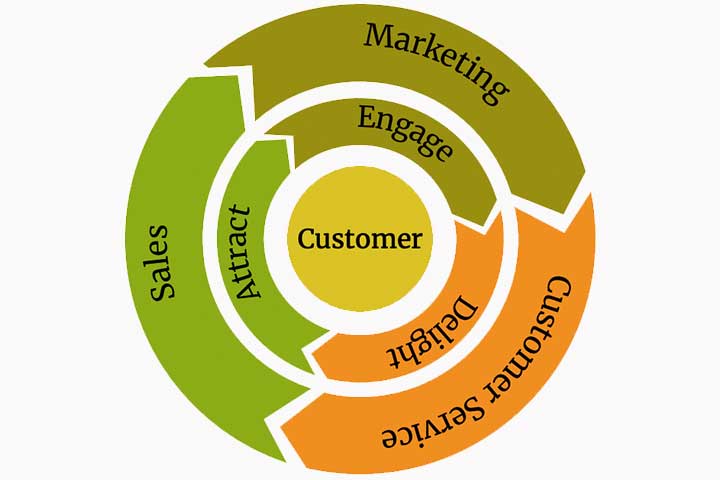The inbound marketing industry is constantly reinventing itself, and the sales funnel that has been so helpful in understanding the customer journey through a buying process now has a strong successor. In the following lines, we talk about what the Flywheel model is and how it can help to structure any conversion and sales strategy.
What is a conversion funnel?
To understand this new model, it is necessary to start with the definition of its predecessor, the sales funnel or conversion funnel. A funnel comprises the steps that a user must take to complete a very specific objective on a website, such as a purchase or registration. For this, the funnel analogy is used, establishing that at the beginning of the process there are many more users than at the end when only those who convert remain in the narrow part of the imaginary funnel.
Thanks to the conversion funnel, it is possible to determine the percentage of losses in each of the steps that users must carry out until they meet the objective set with said funnel. Therefore, it is possible to know what needs to be optimized to improve the results.
What is the Flywheel model?
Translating this term the concept “flywheel” is obtained. If we compare it with the sales funnel, in this case, the analogy becomes with a wheel that turns and turns, instead of a funnel. It would, therefore, be a method that allows energy to flow, maintaining a constant movement, and that only stops by friction, as required by physical canons.
This change in model responds to the also changing behavior of consumers, which is why more and more companies are incorporating the Flywheel in their sales and marketing strategies. A new way to observe and take note of how people go from being strangers to being customers.
Also Read: What Is Marketing Automation? And What Are Its Advantages For Our Company?
How did the Flywheel come about?
The CEO of HubSpot, Brian Halligan, was responsible for applying for the first time inbound marketing strategy one Flywheel model. For this idea, he found inspiration from other sources, such as Amazon CEO Jeff Bezos.
Everything arises because when a person advances through a sales funnel, there comes a time when the procedure is finished and the funnel must continue to be fed. This new model is completely different, as all the energy and resources that are used to attract users will create a pushing force by delighting them that will never stop and the wheel keeps turning.
Any customer can promote and refer the products they have purchased, which automatically feeds the Flywheel model
Anyone who has become a customer can promote and refer the products they have purchased, and this is what will automatically feed the Flywheel model. It is the part of delighting customers that are reflected in this model, which is why it involves a constant and cyclical method of analyzing user behavior.
How does the Flywheel model work?
This new model is based on three pillars or fundamental concepts, which always have the customer as a common denominator, who will appear reflected in the center of the wheel:
- Attract
- To imply
- Delight
incorporating the flywheel into business strategy will improve operations and processes. The resources of the company, in terms of technological infrastructure, should be directed to creating new processes to obtain more efficient customers, since in this new model the customer experience is more important than ever (and ensure that it is as positive as possible).
Currently, it is very difficult to prospect, so the flywheel is an excellent solution. By delighting customers in each phase of the designed process, the goal of becoming brand ambassadors can be met. A satisfied customer will provide the best publicity for a product and service, especially in the age of online reviews and recommendations.
To enhance the effect, in the delight phase, exceptional experiences are offered to customers that add real value to their impressions, so that they are true prescribers of the brand.
And to achieve these objectives, the flywheel is composed of software that has automation in the form of bots or workflow.
Also Read: Top Marketing Trends For 2021
What is going to slow or stop your steering wheel?
Just friction.
This model is very similar to any other daily sales process and, so that it does not stop, it is necessary to locate the friction points, determine what can be automated and, if it cannot be automated, how that friction can be alleviated by relating it to the objectives of the company.
It is important to defend customer needs and create an experience that is based on loyalty and its benefits. The incorporation of new clients is also relevant. If the goal is loyalty, both the company and the customers win.
Usually, friction appears when an adequate after-sales service is not provided or it is not aligned with the culture that exists in the sales and marketing department -which is important that they work in the same line so that the process does not slow down. -.
Another point of friction may be that the software does not work according to the needs of the company and that the information is not updated in real-time, as well as a team that does not work in the same direction.
In summary, the Flywheel model allows companies to design strategies to delight people through specific activities that increase referrals. So that there is no type of friction in the company, it is necessary to develop a unique culture in the service provided.

